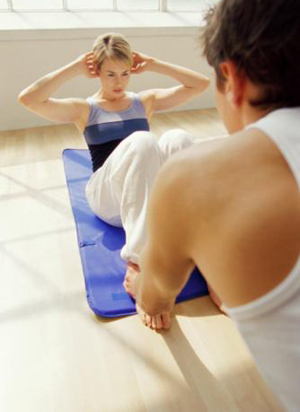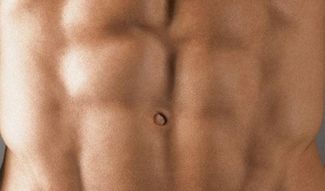Ab Toning: Part II
by Marc David

All About Abs - Nutrition
First Class Eating Habits = First Class Abs 90% of Ripped Ab Gurus Have Fantastic Nutritional Habits
Why Nutrition is 90% or More of Your Success
Let me explain this particular concept as it seems that the current direction is to buy fat burning pills, ab machines and do daily training. The problem is with all that training and other facts is they will never have as much influence on the layer of fat covering your abdominals as a good metabolic meal will that helps your body burn away fat every day.
Turning your body into a fat burning furnace should be your #1 priority.
Eating 5-7 meals per day is critical in order to make your body a calorie burning machine; you must supply it with 5-7 small but frequent meals. The reason you do this is because you will be continually burning calories to utilize the food. Be cautious of portion size. Eat too much of anything and youíll never see those abs!
The more meals you have, the more your body must use energy to burn it. Itís like a furnace. You will RAISE your metabolism simply by eating more frequently.
You see if your nutrition isnít nearly perfect, your body will always store some fat. And that fat will most likely be kept in the abdominal region. The only way to get to the sub-10% body fat region is with rock-solid nutrition. Countless people cannot do this. Their eating habits are never correct, they donít track what they eat and they do not have the discipline necessary to eat correctly all of the time (with some cheat meals in there of course). The group of people who can do that are competitive bodybuilders.
Does this mean you canít do it? Heck no! You just need to be acutely aware that having a ripped abdominal region is about a low percentage of body fat. To get that low, your nutrition needs to be impeccable. The more disciplined you are, the more fat youíll burn and the more muscle youíll keep. The lower your body fat becomes, the more your abs will show.
Itís just that simple but itís not that easy. In the next few steps, you are going to learn exactly what you need to do in order to turn your body into a fat burning machine.
Step 1: Calculate How Many Calories a Day You Need to Lose Fat
Listen, figuring out how many calories a day you need to lose weight really isnít too hard. And with the formula Iím about to give you plus a very cool website, you can easily track where you are and what you need to do daily to reach your goals. So letsí begin!
IF YOU DONíT KNOW WHERE YOU ARE, THEN LOSING, MAINTAINING OR GAINING WILL BE IMPOSSIBLE!
Step 1:
Take your current body weight in pounds (lbs) and multiply by 11.
Example: 194 lbs x 11 = 2134 calories This is what I need to just keep what I have, without moving. But remember, you do move. So you have to then calculate your metabolic factors into thisÖ so off to step 2...
Step 2:
Figure out your metabolic factor according to the table below.
But first, some definitions to help you determine where you might fit in:
Slow Metabolism: You basically look at food and you seem to put on pounds. You can gain weight by eating salads but itís difficult to lose the weight.
Moderator Metabolism: You can gain weight if you try. You can lose weight if you try. You really donít have trouble losing weight depending on what you want to do.
Fast Metabolism: You are the skinny guy or gal who can eat *ANYTHING* and it makes no difference. Gaining weight is difficult. Losing weight can happen overnight. Just by watching T.V. you seem to shed pounds.

Metabolic %
Under 30 years old Slow Metabolism- 30% Moderate Metabolism- 40% Fast Metabolism- 50%
30-40 years old Slow Metabolism- 25% Moderate Metabolism- 35% Fast Metabolism- 45%
Over 40 years old Slow Metabolism- 20% Moderate Metabolism- 30% Fast Metabolism- 40%
Example: 2134 calories x 35% (33 years old and with moderate metabolism) = 746.90
I took my calories needed above just to sit here and not move and multiplied it by my metabolic factor and I find that I need an additional 746.90 calories because of my specific metabolism.
Step 3:
Put it together. 2134 + 746.90 = 2880.90 calories I need 2,880.90 calories to maintain my current weight with my current activities.
Note: You can also adjust your metabolic factor if you do something that might take you to the next level. If you are a moderator metabolism person but you do distance running, it might make more sense to put your self in the fast category since you burn a lot more calories.
Step 4:
Lose Weight: I would take 2880.90 Ė 500 = 2380.90
Note: 500 calories a day is just a general term everybody uses to say that adding this amount is within safe limits. Eat too much, and you end up storing fat. Cut too many calories and your body just goes into starvation mode and ends up retaining more fat. 500 is a safe, recommended guideline. You can also eat 15-20% below your maintenance calorie levels to get a more accurate and aggressive plan. Avoid eating below 20% for very long as your bodyís will start to slow down.
Step 5:
You must track what you are eating so youíll know if youíve made your goal for the day. And tracking food does not have to be complicated with weights and scales.
It's a shame that so many people just start training and never figure out what they need to eat daily to reach their goals.
You can keep doing the math over and over as you reach a goal.
Step 2: Calculate How Much Protein You Need a Day to Keep Muscle
Often overlooked, protein is the key component to building muscle but keep in mind; itís also the same fundamental that will help you keep muscle. What this means to you is that if you get enough protein during this Ďcuttingí phase, youíll burn more fat and keep more muscle. You want to keep as much muscle as possible because you want those abs to show.
As discussed before, having a low body fat percentage is core to the ripped effect but having abs to show is common sense. Protein has many functions that youíve learned about in the Beginnerís Guide to Fitness and Bodybuilding, one of which is to help promote and maintain muscle.

Step 1:
Take your body weight in pounds Example: 194 lbs
Step 2:
Find your body fat % Example: 15.7% (which is .157 for the step below)
Step 3:
Take your body weight in pounds and subtract the % body fat Example: 194 lbs - (194 x .157 = 30.45 lbs of fat) = 163.54 lbs of lean body weight
Step 4:
Take your lean body weight and multiply by 1.14 Example: 163.54 lbs x 1.14 = 186.4g of protein a day
Step 5:
Divide your daily protein requirements by 5-6 meals and that is what your protein target is for each meal. Example: 186.4/6 meals = 31.07g of protein per meal As you will see, a person who is 286 lbs of lean body weight will require a lot more protein. And a person who is 286 lbs should not be consuming the same amount of protein if their percentage of body fat is 35%. But why use 1.14 for protein requirements?
The RDA recommends .75g of protein. But that's been shown to be too low for active athletes.
Some sites will recommend 2.0g of protein. But that seems a bit high and your body will have trouble absorbing that not to mention you will probably have a lot of excess calories which can lead to fat gains.
1.14-1.5 is the most efficient range for most active, healthy adults. This range will help build muscle but not lead you into a high protein diet. Feel free to adjust within that range if you feel you need more protein.
Step 3: Divide Up the Calories in 5-7 Meals Per Day (Ratios)
At this point you know how many calories a day you need to burn fat and how much protein you need to maintain the muscle. Your goal is to burn fat, not lose weight and certainly not lose muscle! Whatís next?
Just divide up your daily calorie requirements by 5-7 meals a day in order to determine the calories per meal and your protein goals.
That might seem like a difficult tasks but once you start using some type of fitness tracking program (like FitDay) it becomes very easy to hit your targets and understand portion control.
If you donít track what you are eating, then dividing this up will be nearly impossible unless you eat the same things every single day (boring).

Thereís nothing fancy to this step.
Preparation Ideas:
* Grocery shop for the entire week so you have an ample supply of food
* Prepare things in bulk so putting together meals is quick and easy
* Use Tupperware as itís easy to clean and easy to control portions
* Use the grocery list from the Beginnerís Guide to pick and choose foods that are proteins, carbohydrates and good fats
Step 4: Review the Nutritional Fundamentals
On page 68 of the Beginnerís Guide there are some nutritional fundamentals that you must master overall in order to get your nutrition dialed in and it working for you. When you turn your body into a fat burning furnace you need to review these key concepts.
* Eat about 15-20% below your calorie maintenance level. If you use a more aggressive calorie deficit, then do not keep calories too low for too long; increase calories to maintenance or maintenance +10-20% 1-2 days per week. * Getting your ratios correct (50% protein, 30% carbs, 20% fats) * Eating 5-7 meals per day * Having a lean protein source with every meal * Getting the good fats and avoiding the bad fats * Drinking enough water * Eating as many natural and unrefined foods as possible * Keeping your total fats and saturated fats low. A little bit of good fats (seeds, flax, fish) is better than a no fat diet.
Stay tuned for Part 3 that will discuss Ab training and the question that everybody wants to know - How Many Times Per Week to Train Abs?
Copyright 2006 Marc David
About The Author:
 Marc David is an innovative fitness enthusiast and the creator of the "The Beginner's Guide to Fitness And Bodybuilding" method on www.Beginning-Bodybuilding.com. He can show you how to reduce your body fat thru diet, how to gain weight or create more muscle thru an abundance of workout tips by training LESS! Not more. He dispels many "bodybuilding myths", tells you what most people never realize about nutrition, and what the drug companies DON'T WANT YOU to know. Go to: http://www.Beginning-Bodybuilding.com to find out more about The Beginner's Guide to Fitness And Bodybuilding.
Marc David is an innovative fitness enthusiast and the creator of the "The Beginner's Guide to Fitness And Bodybuilding" method on www.Beginning-Bodybuilding.com. He can show you how to reduce your body fat thru diet, how to gain weight or create more muscle thru an abundance of workout tips by training LESS! Not more. He dispels many "bodybuilding myths", tells you what most people never realize about nutrition, and what the drug companies DON'T WANT YOU to know. Go to: http://www.Beginning-Bodybuilding.com to find out more about The Beginner's Guide to Fitness And Bodybuilding.
More Articles by Author Marc David
Return to the Workout Articles Archive
|